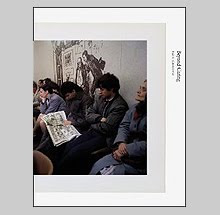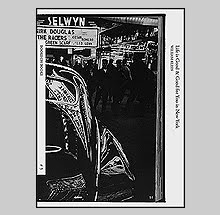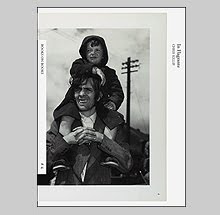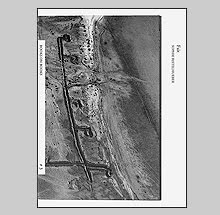Anselm Kiefer: Books 1969 - 1990
I will admit right from the get go that I feel way in over my head when trying to write about this next artist. Probably because my initial response to a lot of art is to define its meaning and a discomfort arises when the work is resistant and asks the viewer to experience the work and then live with the consequences of that experience. Anselm Kiefer's art seems in large part to want to remain enigmatic. By drawing on iconography from such varied sources that are largely unfamiliar to me in Germanic and Nordic culture, history, the Jewish Kabbalah, alchemy, and mythology, the deeper meanings feel forever just out of my grasp. I am sure whatever I divine from the work is only scratching the surface. That being said I often find his paintings, leaden sculpture and certainly the artist books vastly compelling.
There are many books published on Kiefer's work that lend entire sections to the discussion of his artist books but there was title published in 1990 by Edition Cantz und Autoren on the occasion of a traveling exhibition dedicated entirely to 21 years of his book craft called Anselm Kiefer Books 1969 - 1990. Now somewhat rare and costly, this edition is by far one of my favorite books on artist books in my collection.
For Kiefer, making books has been a major part of his work since 1968. What interests me about his artist books is that he incorporates not only photography into their making but many of the other materials such as sand, straw, tar, and lead. The physicality of his books expands the notion of what can comprise a book. These are handmade, one-of-a-kind objects that seem delicate and prematurely aged. I can imagine that these books are not handled very often but it seems that by incorporating these physical materials, part of what the artist was interested in was their change over time through use.
Much of Kiefer's work has been controversial because of what he saw as a necessity to boldly confront the horrors of
Often Kiefer's books and paintings will recycle subject matter at different times throughout his career. In terms of books, often they appear as a series based upon a theme. One fine example is called Die Uberschwemmung Heidelbergs of which there are five books that share that title differentiated by Roman numerals. The cover of the first book of this series displays a historical photograph of soldiers alongside a gigantic antiquated cannon. The book mixes references to war and the establishment of the foundations of Nazi-ism alongside images of what appears to be the chaotic paper strewn studio of the artist. Towards the end of the book, landscape photographs (of
Das Deutsche Volksgesicht Kohle fur 2000 Jahre (The Face of the German People: Coal for 2000 Years) created in 1974, is a curious mix of two books -- one mounted to the face of another larger book. The smaller seems to be an actual offset book of German faces that was printed for public distribution; Kiefer's contribution in the larger book is a series of charcoal drawings overprinted with the texture of wood that give the impression of people ingrained into the land.
Ausbrennen des Landkreises Buchen (The Cauterization of the Rural District of Buchen) also from 1974 utilizes the common imagery in Kiefer's work of the barren landscape. It is this work that might be most comparable to the photography of the Japanese provoke era. Most of Kiefer's photographs whether made by him or appropriated draw attention to their deteriorating surfaces either through chemical contamination, print fogging, splotchy development or other means. The heavy grayness accentuated by the muddy landscapes and tonally darkened skies steers the viewer towards a mood that expects the worst possible outcome. This book progresses through fields that become covered with fire smoke until the book becomes double-page spreads of textured black. The last few spreads take on the tonality of ash.
The next book could possibly be one of Kiefer's most accessible. It was the first for me that provoked a deeper interest in Kiefer's work. Sigfried's Difficult Way To Brunhilde made in 1977 is a book of 108 pages of double-page spread photographs that Kiefer made while walking along abandoned railway beds. For obvious reasons, railroad tracks provoke unwanted memories of their used during wartime. In this work in Kiefer parallels this history with the third cycle of Wagner's opera The Ring. Each photograph essentially describes the same view standing in the center of the railway bed and looking off into the distance and following the diminishing perspective. The railway bed itself, for the most part lacking actual rails, takes on further significance when the piles of rocks that make up its foundation conjure association to images describing piles of shoes and eyeglasses of victims of the Holocaust. Within the last 10 pages of the book, painted fire appears on the horizon in direct reference to Wagner's hero Siegfried entering the ring of fire surrounding Brunhilde as well as the crematoriums used in the Final Solution.
A shift occurs in the 1980s where Kiefer's allegorical or metaphorical subjects shift from the physical world and history towards the spiritual. This occurrence is in keeping with Kiefer's original provocations to face difficult history in order to heal the self.
These are but a few of the 33 artist books illustrated in Anselm Kiefer: Books 1969-1990. This is not a complete catalog of all of this book works between these years but it definitely illustrates the range of not only subject but physicality of his books. It was published in both hard and soft cover. Due to the size and thickness my softcover edition seems very susceptible to damage to the spine. The reproductions seem faithful to the originals although in other books the same exact copy photographs are often reproduced with much more contrast, richness and density. This book was published in both German and English editions and features essays by Gotz Adriani, Peter Schjeldahl, Toni Stoose and Zdenek Felix.
Note: The illustrations used in my composites were scanned from a book on Anselm Kiefer by Daniel Arasse that was published by Abrams in 2001. Although the book described above contains hundreds of illustrations of spreads from these artist books, I chose to scan from this lesser valuable title to keep from damaging the spine of the other. Most of the illustrations shown above appear in Anselm Kiefer Books 1969-1990 but some may vary.


















